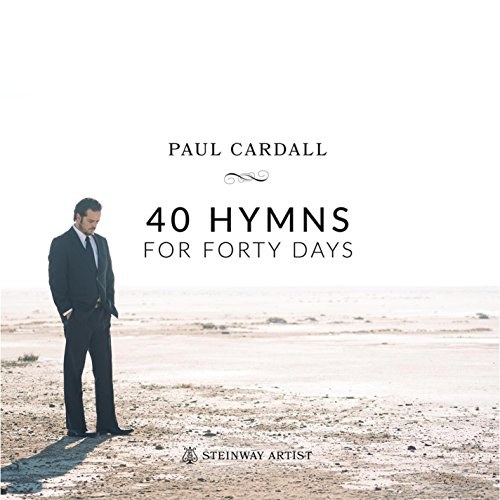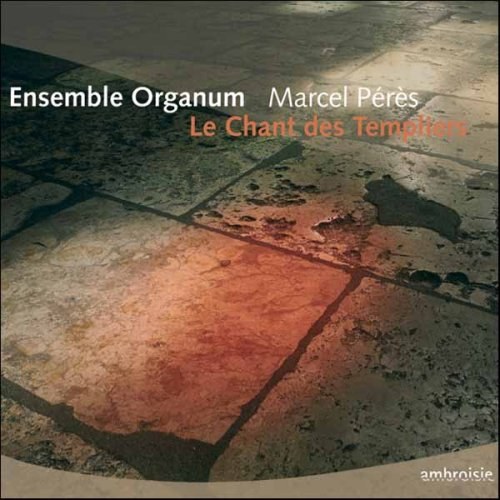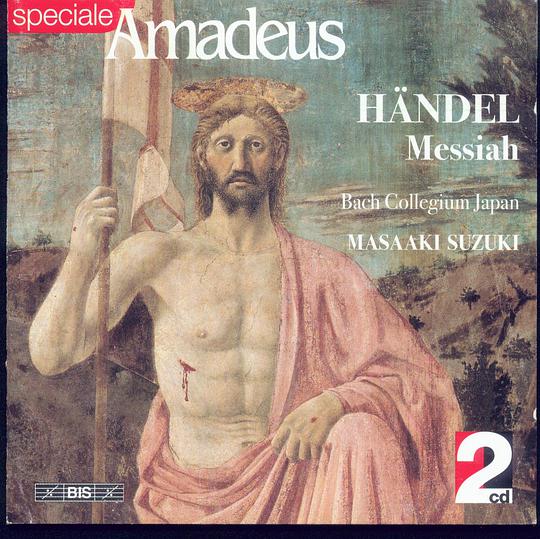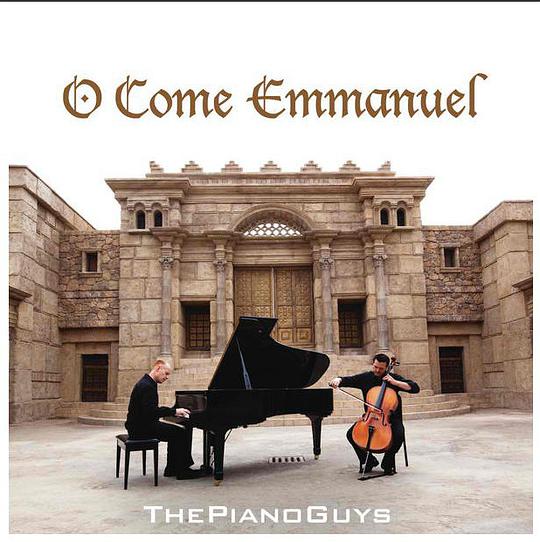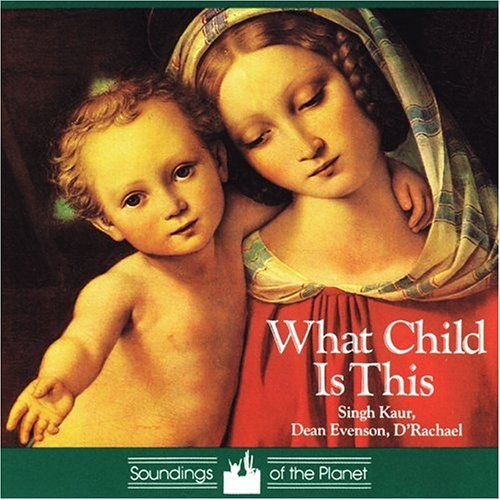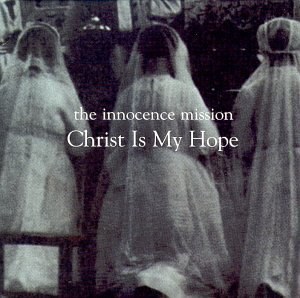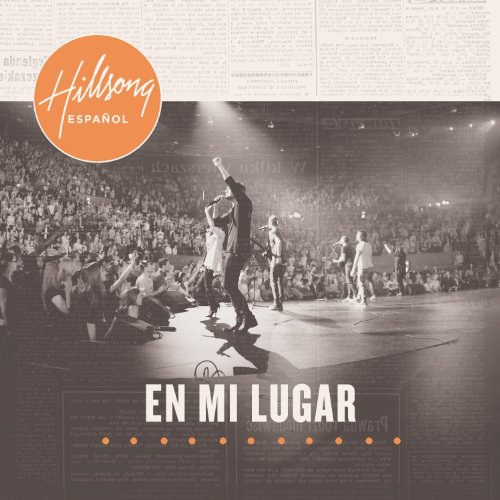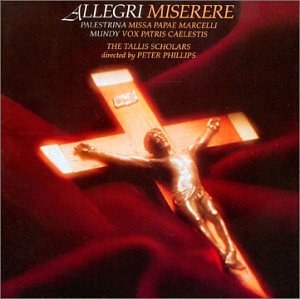这张是名版,听遍The Sixteen, King's Choir 等等以来的最好选择。求主垂怜歌词可见诗篇51章,是文艺复兴时期代表作。这里有个有关莫扎特的小插曲。miserere mei,deus原是西斯汀礼拜堂的保留曲目,主教规定任何抄本都不得外传,因为声部太多,没有人能完整把它记下来。自从小莫扎特去听了以后市面上就出现了各种手抄本。。。囧。。。
Allegri's Miserere and Palestrina's Missa Papae Marcelli are widely recognised as being of the finest music to come from the Golden age: they must receive more performances throughout the world than any other pieces of unaccompanied sacred music. We introduce William Mundy's Vox Patris caelestis in order to establish the reputation of a masterpiece and of an English composer. It happens that Mundy wrote Vox Patris caelestis in almost exactly the same year as Palestrina wrote his Missa Papae Marcelli; by coupling them we can appreciate the extraordinary variety in sacred music which existed at that time between England and the continent.
Allegri's Miserere is quite simple in conception and much of its impact relies on the conditions of performance, especially on the acoustic. The Tallis Scholars have used a reverberant building - Merton College Chapel in Oxford - and placed the solo group at some distance from the remainder of the choir. There are five sections in the music, which are identical except for the second half of the final verse where the solo group and the main choir at last join up, singing from the extreme ends of the chapel. The musical effect is created by Allegri's use of discords (caused by a series of suspensions) and by embellishments around a straight-forward vocal line, which take the solo treble to a high C. The text is the whole of Psalm 51, perhaps the most penitential of all the psalms, traditionally sung in the Anglican rite on Ash Wednesday and in the Catholic rite during the last three days of Holy Week.
The history of the composition has been a colourful one: the Papacy, realising that it owned a composition of exceptional appeal, shrewdly heightened its reputation by refusing to allow any copy to leave the Sistine Chapel. This ban was supported by threats of severe punishment. According to some commentators, the monopoly was only broken when Mozart heard it and wrote it out afterwards from memory. Whatever the cause, there were several copies in circulation in Europe by the mid-18th century and the number has greatly increased since, though never have there been so many differing versions of what purports to be the same piece.
A similarly colourful story, though with less foundation in fact, is attached to Palestrina's Missa Papae Marcelli. Following the jolts given them by the Reformation, the Catholic cardinals decided, amongst other things, that church music had become too long-winded and the words inaudible. They were on the verge of banning all polyphony and perhaps returning solely to the performance of plainsong, when Palestrina wrote this Mass and proved by it that good music need not be unnecessarily protracted, and the words need not be obscured. Palestrina was held to have 'saved church music'. In fact many compositions in this more syllabic style must have proved the point to the cardinals, but if this work has achieved pre-eminence, it is on grounds of quality. It was probably written in 1556 and dedicated to the memory of Pope Marcellus II, who had reigned only three weeks in 1555.
There are five movements - the repeat of the Hosanna making the Benedictus musically part of the Sanctus. The richness of Palestrina's writing comes from his predominant use of lower voices - two tenors and two basses - with one countertenor and one treble. In Agnus Dei II, which takes the form of a canon between the first bass (the leading voice) with the second countertenor and second treble, the choir is completely rescored for two trebles, two countertenors, tenor and two basses.
Vox Patris caelestis was written during Queen Mary's reign (1553-1558) and so is exactly contemporary with the Missa Papae Marcelli. It can be so precisely dated because it was written in a style which was unacceptable to the Protestant Tudor monarchs - Edward VI and Elizabeth I - and Mundy was too young to have written it in Henry VIII's reign. The Catholic musical style which Mary encouraged was a very different one from the Papacy's ideal in the 1550s: Mundy composed on an enormous scale and to him the audibility of the words was of secondary importance beside the free expansion of the melodies, though he clearly appreciated the sensual connotations of his text, which is adapted from the Song of Solomon, as in, for instance, the repetitions of the word 'Veni'.
The underlying structure of the music is of the greatest importance to its effect, and for this reason we have printed the words divided into their sections. The solos build gradually to the three full sections, of which the last is the climax on the words 'Veni, veni, veni: caelesti gloria coronaberis. Amen'. To build the more strongly to this last full section, the solo sections also increase in intensity, the last of them using the most spectacular scoring of voices which was available: two trebles, two means and two basses.
© 1980, rev. 1990 Peter Phillips.
